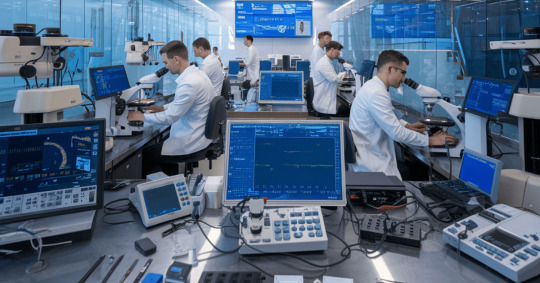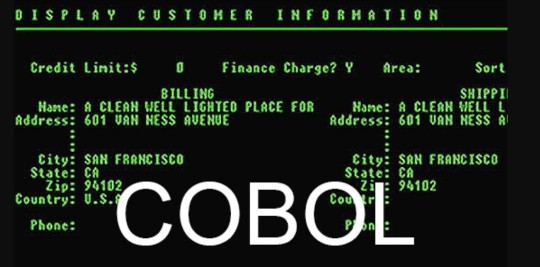#LegacySystems
Explore tagged Tumblr posts
Text
1962 Mainframe with Bluetooth
This old computer is comprised of four big boxes, three of which are ever actually used.
The UNIVAC 1219. This is the brains of the system. It controls the operations of every other device. This is what I'm referring to when I'm not gesturing to the UNIVAC 1219 as a whole.
The UNIVAC 1540. This is the DDR, or Digital Data Recorder. It holds, writes, and reads the magnetic tape operators load into the machine.
The Digital to Analog Converter. The UNIVAC 1219 was the first digital computer on most U.S. Navy ships, most of which had analog weapons systems. This hulking mass of steel translated the digital signals from the computer to the analog signals of the weapon systems and vice versa in regards to the radar.
The UNIVAC 1532. The I/O console managed the...you guessed it, input and output of the UNIVAC 1219. You can load and punch paper tape for programs more bite-sized than would be used for magnetic tape.
In addition, we have two teletype machines. You can think of them like typewriters that don't receive human input (except the one that can if we want), but instead output what the computer tells it to. We have a Teletype Corporation teletype that is optimized for character compatability and a Kleinschmidt teletype that is optimized for speed. Both rely on the I/O console to send and receive data.
The real ingenuity begins with the floppy drive. Duane, who's career revolved around this system, developed a way for a floppy drive to imitate the I/O console. The computer thinks it is reading and writing to a paper tape, when it is in fact reading and writing to a 5.25in floppy inside an ancient CNC machine floppy drive.
And this, dear reader, is where the magic happens. This framework was originally built for interfacing with the 1219 via BIN files over Serial port and was easily changed to support BIN files over floppy. Duane has been working on an off adapting our purple converter box with a raspi to let the 1219 read and write BIN files over Bluetooth.
Make no mistake, you cannot simply SSH into this machine as tons of setup and channel changes must be performed to ready it to receive and send data. That being said, I don't see any other UNIVAC mainframes with Bluetooth [or any other running UNIVAC 1219s at all :(], so I will take what I can get.
Can someone tell me how to Tumblr properly?
#VintageComputing#Mainframe#UNIVAC#RetroTech#ComputerHistory#OldTechnology#LegacySystems#HistoricComputers#AntiqueTech#ComputerArchaeology#VintageHardware#ComputingPioneers#UNIVAC1219#ClassicComputing#DigitalArchaeology#computer#new jersey#us navy#u.s. navy#navy#old computers#new blog#new user#technology#tech#vintage computing#retro computing#retro tech#retro#retro computer
150 notes
·
View notes
Text
Despite the rapid rise of FinTech, the backbone of modern banking remains COBOL, a programming language developed in 1959. This article explores how legacy financial systems continue to run on COBOL due to risk aversion, stability, and reliability. Financial institutions prioritize uptime (99.999%) and avoid system-wide replacements unless absolutely necessary. While FinTech boasts cutting-edge interfaces, critical financial transactions—like account creation and fund transfers—still rely on COBOL’s structured efficiency. The takeaway? New technology may evolve, but old, reliable systems refuse to fade away.
#COBOL, #FinTech, #bankingtechnology, #legacysystems, #financialstability, #riskaversion, #bankinginfrastructure #archive
#COBOL#FinTech#bankingtechnology#legacysystems#financial stability#risk aversion#banking infrastructure#archive
2 notes
·
View notes
Text
"Working Effectively with Legacy Code" by Michael C. Feathers is a must-read for developers and software engineers who deal with legacy systems. Legacy code, often characterized by its complexity, lack of documentation, and resistance to change, can be daunting to work with. This book provides practical strategies and techniques to understand, refactor, and improve legacy codebases. Below is a user-friendly, step-by-step breakdown of the key outcomes and takeaways from the book.
#LegacyCode#Refactoring#SoftwareDevelopment#CleanCode#CodeRefactoring#TechBooks#SoftwareEngineering#WorkingWithLegacyCode#MichaelFeathers#LegacySystems#CodeQuality#TechTutorial#SoftwareMaintenance#DevelopmentBestPractices#TechEducation#SoftwareCraftsmanship#LegacyCodeTips#RefactorLegacyCode#ProgrammingBooks#TestDrivenDevelopment#AgileDevelopment#SoftwareDesign#TechLeadership#ProgrammingBestPractices#DeveloperTools#TechCommunity
0 notes
Text
#LegacyModernization#AppModernization#DigitalTransformation#ModernSoftwareSolutions#EnterpriseTech#BusinessGrowthTech#TechUpgrade#LegacySystems#CloudMigration#ModernizeYourBusiness
0 notes
Text
Future-Proof Your Business with Charon Legacy System Emulation
With Legacy System Emulation Solutions, businesses can virtualize VAX, Alpha, PA-RISC, and SunSPARC systems, running them securely on modern hardware or the cloud.
1 note
·
View note
Text
Legacy Software Modernization - Sparx IT Solutions
Know how to modernize your legacy software with Sparx IT Solutions. Get tailored strategies to enhance performance, reduce costs, and stay competitive in the digital age.
#Legacy software modernisation#Legacy software migration#LegacyModernization#SoftwareModernization#DigitalTransformation#LegacySystems#ITModernization#SoftwareUpgrade#TechInnovation#CloudMigration#ApplicationModernization#BusinessTransformation#SoftwareDevelopment#ITInfrastructure#FutureReadyTech#SparxITSolutions#TechSolutions#ModernizeLegacy#SoftwareOptimization#ITConsulting#EnterpriseSolutions#TechUpgrade
1 note
·
View note
Text
The Backbone of Modern Technology: Why Quality Components Matter

In the fast-paced world of technology, every innovation, from advanced medical devices to electric vehicles, relies on one critical element: the quality of its components. A single flawed microcontroller or power management IC can ripple through the supply chain, impacting performance, safety, and reliability.
For businesses operating in high-stakes industries like automotive, industrial automation, and healthcare, sourcing components is more than just a transactional process—it's about ensuring the integrity of their systems. This is where trusted sourcing solutions come into play.
🔍 If you’re working with legacy systems or need specialized components, understanding the sourcing landscape is essential. Learn about the roles of authorized distributors and independent channels in delivering both active and hard-to-find components without compromising quality.
👉 Discover how to unlock quality and reliability with Renesas authorized distributors and build a sourcing strategy that stands the test of time.
💡 Fun Fact: Did you know that sectors like renewable energy and IoT are pushing the boundaries of what modern components can achieve?
Let’s keep driving innovation—one reliable part at a time. 🚀
#TechnologyInnovation#ElectronicComponents#SupplyChainManagement#Renesas#AuthorizedDistributors#LegacySystems#ComponentSourcing#IoT#IndustrialAutomation#SmartSourcing#ReliableParts#TechTrends#SustainabilityInTech
1 note
·
View note
Text
0 notes
Text
Transforming Legacy Systems: How Interoperability Paves the Way for Banking Innovation

In the rapidly evolving world of finance, banks are under increasing pressure to modernize their core systems to stay competitive. However, this transformation is often a daunting task, filled with complex decisions and significant investments. Enter interoperability—a game-changer that simplifies this challenging process and offers a clear path forward.
The Modernization Challenge
Banks are built on legacy systems that have served them well for decades. However, these systems are now a hindrance, slowing down innovation and making it difficult to integrate new technologies. The dilemma lies in the risk and cost associated with overhauling these core systems while ensuring continuous service to customers.
Interoperability: The Missing Piece
Interoperability, the ability of different systems to communicate and work together, is the key to overcoming this modernization challenge. By enabling seamless integration between new and existing systems, interoperability allows banks to upgrade their technology without the need for a complete system overhaul. This approach reduces risk, lowers costs, and allows for a more gradual, manageable transition.
The Benefits of Interoperability
Cost Efficiency: Interoperability allows banks to leverage existing infrastructure, reducing the need for expensive, large-scale replacements.
Flexibility: Banks can adopt new technologies at their own pace, integrating them with existing systems to create a hybrid environment that supports innovation.
Enhanced Security: With interoperability, banks can implement advanced security features across all systems, ensuring data protection while modernizing.
Improved Customer Experience: By modernizing incrementally, banks can continuously improve their services without disrupting the customer experience.
Real-World Examples
Several banks have already begun leveraging interoperability to ease their modernization journey. By adopting open banking standards and APIs, they have integrated fintech solutions into their core systems, offering customers new services without a complete system overhaul.
Outcome
Interoperability is not just a tool; it's a strategic approach to core banking modernization. By solving the puzzle of legacy systems, it offers banks a way to stay competitive, innovate, and meet the demands of the digital age—without the risks and costs traditionally associated with such a transformation.
As the financial landscape continues to evolve, banks that embrace interoperability will be well-positioned to lead the charge into the future.
0 notes
Text

Expert COBOL Application Development Services | Chetu
Explore Chetu's expert COBOL application development services to modernize your legacy systems. Our solutions enhance efficiency and scalability for your business.
0 notes
Note
Hello! Welcome to tumblr, I'm already a massive fan and I was wondering what exactly the UNIVAC was used for back in the day and what kind of functions you have it perform for demonstrations now? Thank you!
Oh my goodness, my first question! Well, in a sentence, the UNIVAC 1219 was used to point and fire missiles at enemy aircraft. Now, we can break this down:
The UNIVAC 1219 is a militarized version of the UNIVAC 418. This thing has better resistance to salty air and other things you’d want a seafaring computer going into battle to have, but at their hearts they’re the same. There were three different missile systems the UNIVAC was a part of: Talos, Terrier, and Tartar. These three systems were among the first sea-to-air missile systems fielded by the U.S. Navy.
The UNIVAC 1219 would receive data from the AN/SPG-55 radar and analyze the data it received. Running one of dozens of programs lost to time (or on a single last-of-its-kind magnetic tape we are worried about damaging), it will pass on the results of its calculations to the missile system itself. The missile will go where it is told, and hit an enemy plane.
But our UNIVAC 1219 is unique! The specific machines here are from the John Hopkins Applied Physics Laboratory. At John Hopkins, they developed the fire control programs ran on Navy ships! They had a radar and everything, and I only wish we had a radar and missile battery too ;D.
As for what we do for demonstrations, we have assortments of cool programs we run, and I encourage you to swing by and see for yourself. Our oldest party trick is printing ASCII art of Spock and George Washington, but maybe if this post performs well I will divulge some other cool things we do ;).
Thank you for the question! I am loving this blog rn and appreciate the great support you all have given me.
#VintageComputing#Mainframe#UNIVAC#RetroTech#ComputerHistory#OldTechnology#LegacySystems#HistoricComputers#AntiqueTech#ComputerArchaeology#VintageHardware#ComputingPioneers#UNIVAC1219#ClassicComputing#DigitalArchaeology#computer#new jersey#us navy#u.s. navy#navy#old computers#new blog#new user#technology#tech#vintage computing#retro computing#retro tech#retro#retro computer
36 notes
·
View notes
Text
youtube
#Legacy Systems#CX Challenges#Customer Experience#Stranger Things#Legacy Software#Bulk Communication#Automation#Marketing Campaigns#Communication Campaigns#Calling Campaign#Call Centre Scripting#Customer Communication#LegacySystems#CXChallenges#CustomerExperience#StrangerThings#Legacysoftware#CallCentre#CommunicationCampaign#CommunicationJourney#CallScripts#Youtube
0 notes
Text
1 note
·
View note
Text
Legacy Application Modernization | Legacy System Modernization | Legacy Modernization ServicesLegacy application modernization can help you rearchitect, rebuild, or replace legacy systems that have become obsolete. Legacy application modernization help retain customers, drive business growth, and remain competitive. OmnePresent's Legacy Modernization Services can help you modernize your outdated systems. Contact us to know more.
1 note
·
View note
Text

Modernization: Transforming Core Legacy Systems with Low-Code Enterprise App Development
Low-code platforms improve in accelerating enterprise application development to fulfil (and even surpass) business expectations. To learn more about Low-Code Enterprise App Development and how it can transform core legacy systems, read this blog.
Read more: https://www.prolim.com/low-code-it-modernization/
Discover how PROLIM leverages Mendix solutions for Digital Transformation. https://www.prolim.com/mendix/
We encourage you to leave a comment and provide us with valuable feedback.
For more information, contact us at [email protected]
#ThinkPROLIM#DigitalTransformation#TodayMeetsTomorrow#mendix#LowCode#Digitalization#LowCodeDevelopment#Automation#digitaltwin#innovation#legacysystems#Modernization
1 note
·
View note